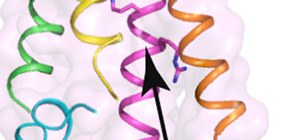
Elucidation at the atomic level of the structure of a voltage-gated hydrogen ion channel
Will likely create a ripple effect in the development of new drugs and more
A group of researchers at Osaka University led by TAKESHITA Kouhei (Visiting Researcher, Institute for Protein Research), NAKAGAWA Atsushi (Professor, Institute for Protein Research) and OKAMURA Yasushi (Professor, Graduate School of Medicine) clarified the shape of a voltage-gated hydrogen ion channel controlling the flow of hydrogen ions when our body attacks pathogens and clarified the mechanism for permitting the permeation of hydrogen ions as needed. This group's achievement will make it possible to design chemical compounds which put a cover over the gate for hydrogen ions and will lead to the development of new drugs for a variety of diseases.
It is well known that electric signals are used in neurotransmission and the beating of the heart. The structure elucidated by this group helps detail, at the atomic level, how these electric signals are controlled in the body. The term pH represents the hydrogen ion concentration in a solution that plays a role in maintaining body homeostasis. In 2006, Professor Okumura discovered voltage-gated hydrogen ion channels (proton channels), a voltage dependent membrane protein consisting of two modules: the voltage sensor and phosphatase. These ion channel molecules form conduction pathways for hydrogen ions in the cell membrane; however, they are not always open, opening only when the voltage sensor detects electric signals.
These proteins act as voltage sensors, detecting potential changes both inside and outside the cell. However, questions about the hydrogen channels remained such as "How is it that the smallest of all ions, hydrogen ions, are only let out when necessary?" and "Where is the sensor located that detects potential changes both inside and outside the cell?" remained unknown. By using the beamline particle accelerator BL44XU at the synchrotron radiation facility SPring-8, this group was able to examine the atomic structure of the hydrogen ion channel. The structure showed a 'closed umbrella' shape with a long helix. This group found zinc ions closed the hydrogen ion channel in a manner similar to the way a Japanese umbrella closes. Furthermore, the group also found that the sensor was on the part equivalent to the axis of the umbrella and it opened and closed the hydrogen ion channels by vertically sliding on the axis.
This group has elucidated how the sensor only allows the permeation of hydrogen ions when necessary. Their achievement will lead to further clarification of mechanisms of life phenomena. The ion channel they discovered is one of the smallest molecules in human ion channels. Further research on this small molecule will clarify principles regarding membrane proteins, a target of drug research. This group's achievement will likely create a ripple effect in the development of new drugs and biomolecular devices.
Abstract
Electrical signals play critical roles in heart beating, sensation, memory and metabolism. Voltage-gated ion channels are key proteins that function in cellular membranes for electrical signals. Hv1 (VSOP) is the unique ion channel protein that was discovered in Japan. It has a voltage-sensor domain (VSD) with dual roles of voltage sensing and proton permeation. Its gating of proton conduction pathway is sensitive to pH gradient and extracellular Zn2+ succeeded to solve a crystal structure of mouse Hv1 in the resting state at 3.45 Å resolution.
The structure showed a ‘closed Wagasa (Japanese umbrella)’ shape with a long helix running through the cell membrane to the cytoplasm and featured a wide inner-accessible vestibule. Voltage sensing amino acids on the protein were located below the phenylalanine-containing “gascket” region in the center of membrane, indicating that structure was in resting state.
The extracellular region of each protomer coordinated a Zn2+ fluid to suppress sperm motility before ejaculation. These findings provide a platform for understanding the general principles of electrical signals in neuron and muscle, and pH homeostasis in blood cells.
Figure 1
To learn more about this research, please read the full research report entitled " X-ray crystal structure of voltage-gated proton channel " at this page of the Nature Structure & Molecular Biology website.
Related links :
- Laboratory of Supramolecular Crystallography, Research Center for Structural and Functional Proteomics
- Integrative Physiology, Graduate School of Medicine & Frontier Biosciences
- Laboratory of Supramolecular Crystallography, Research Center for Structural and Functional Proteomics, Institute for Protein Research
